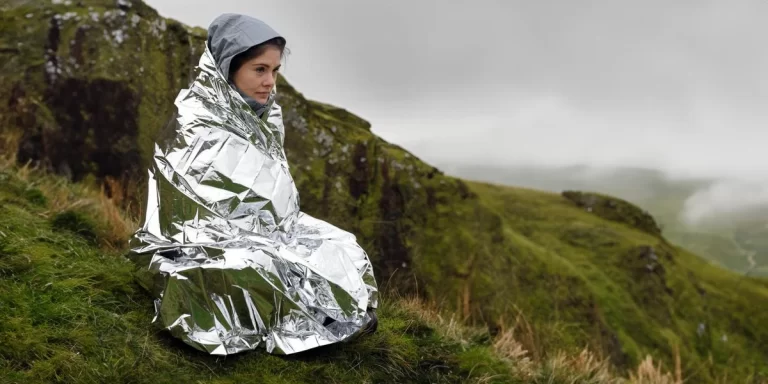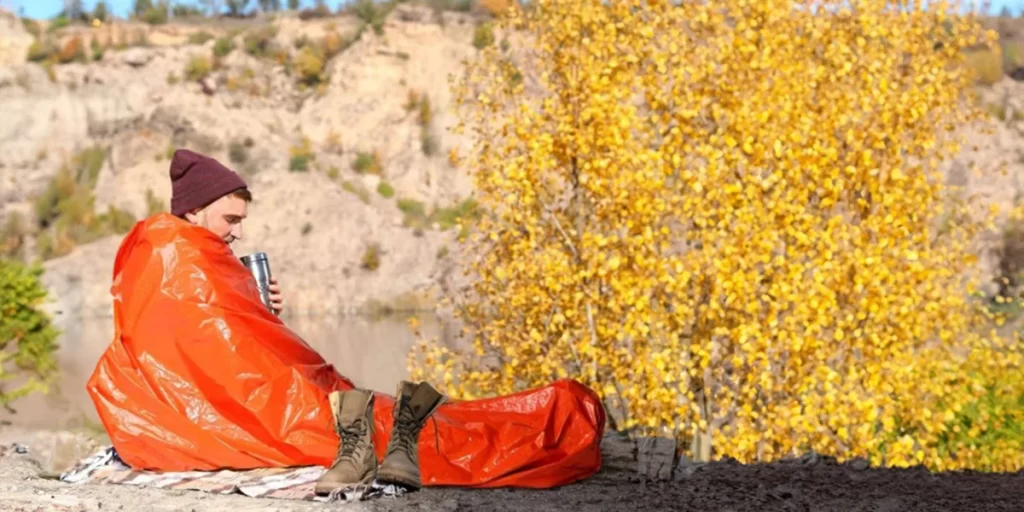

When you’re out in the wild, safety matters most. That’s where the survival blanket comes in. It’s a small, lightweight wonder that can make a big difference when things don’t go as planned.
In this post, we’ll explore why the survival blanket is a must-have for outdoor enthusiasts. Curious? Keep reading to uncover its secrets and discover why it’s an essential tool for your outdoor adventures.

So, what exactly is this thing called a survival blanket? Imagine a super-thin, shiny blanket that can do wonders to keep you warm or cool. That’s what a survival blanket is all about.
It’s also known as a space blanket or emergency blanket. Here’s why it’s so crucial:
It’s worth noting that there are also sleeping bags, bivys and extra-durable versions of the same material and concept. The following considerations apply to those as well.
Survival blankets might seem like they’re from the future, but their origins are pretty down-to-earth, or should we say, out-of-this-world. Here’s the scoop on the science that makes them so incredible:
Space-Age Tech: Survival blankets have an unexpected link to space. In the 1960s, as astronauts ventured into outer space, scientists devised “vacuum metallization” to shield their equipment and themselves from the blazing sun.
Vacuum Metallization is a fancy term that involves coating a non-metal surface (like super-thin polyester film) with a layer of metal, usually aluminum. This shiny aluminum layer is what gives these blankets their superpowers.
So, how does this shiny stuff work? It’s all about reflecting heat. You see, it bounces back those invisible heat rays (called infrared rays) like a mirror. Instead of letting heat in, it keeps it out or, even better, traps it inside.
So, how does this shiny stuff work? It’s all about reflecting heat. You see, it bounces back those invisible heat rays (called infrared rays) like a mirror. Instead of letting heat in, it keeps it out or, even better, traps it inside.
Let’s talk about how they become your outdoor heroes when things get tough:
Remember, if your blanket has two sides, gold on the outside provides protection against the cold, while silver on the outside provides protection against the heat.

Survival blankets sound pretty amazing, right? Well, they are, but they’re not without a few quirks you should know about:
Survival blankets, akin to Swiss Army knives for outdoor safety, shine brightest when paired with other gear. Here’s how to maximize their use:
Remember, the key to outdoor safety is being resourceful. Survival blankets are versatile tools that can adapt to various situations, so don’t hesitate to get creative with how you use them alongside your other gear.
So, whether you’re braving the wilderness or preparing for unexpected twists, the survival blanket proves its worth as a reliable companion.
Its lightweight design and multifunctional capabilities make it a staple for any outdoor adventure.
Embrace its secrets, pair it wisely with your gear, and let the magic unfold in your journey of exploration and safety.
Looking for an ultralight survival blanket or a bag? Check out our TOP 5 guide for various options.
Certainly, survival blankets are generally reusable as long as they aren’t damaged or torn. Their durability depends on factors like the quality of the blanket and how well it’s cared for. Proper folding and storage can extend their lifespan. However, it’s essential to inspect them regularly for any signs of wear and tear. If they’re in good condition, you can use them multiple times for various outdoor adventures and emergencies.
The lifespan of a space or survival blanket can vary, but with proper care and minimal use, they can often last for several years, typically ranging from 2 to 5 years or more. Regular inspections for wear and tear are advisable, and long-term storage in a cool, dry place away from UV radiation and moisture can extend their usability. However, it’s important to note that these values are approximate, and actual lifespans may vary depending on factors like the blanket’s quality and exposure to environmental conditions.